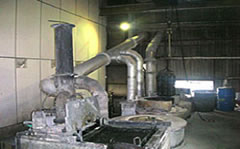By heating up chemicals, such as potassium chloride, sodium chloride and sodium nitrite, they melt together to form the salt solution. In salt bath quenching, a product is heated in a tank filled with this salt solution and then quenched in the low temperature salt solution.。
A normal quenching uses an electric or gas furnace, but there is risk of uneven thermal conduction due to steel property or its dimension, and thus causing uneven hardness, distortion and cracking.
Salt solution has better thermal conductivity than gas, so it heats up the subject uniformly. Because the salt solution touches the subject directly during the cooling, uneven cooling is difficult to occur. This also leads to metallographic stability and lowers the risks mentioned above. The use of a salt bath at heating acts as a protective film, which prevents oxidation and minimizes the formation of oxide film.

Characteristics of salt bath quenching
| ○ | Low distortion (50% to 30% less than other methods) |
|---|---|
| ○ | It cools with uniform thermal conduction to reduce uneven hardness and cracking. |
| ○ | The salt solution acts as a protective film during quenching to lower the risk of decarburizing. |
| ○ | We have an open-type furnace to handle rush orders. |
| × | The high maintenance cost of a salt bath furnace combined with the rising costs of environmental measures (industrial waste disposal of cleaning chemicals after salt bath quenching) makes it relatively expensive compared to other methods. |
Characteristics of our company
| ・ | With our original method, S45C can achieve HRC60 and above. Even rolled steel for general structure can achieve HRC55 and above. |
|---|---|
| ・ | Our open furnace can treat products upon arrival to make short delivery time possible. We can flexibly deal with small lots and single piece orders. |
| ・ | We can treat in 2 hours at shortest. |
Equipment
|
 |



